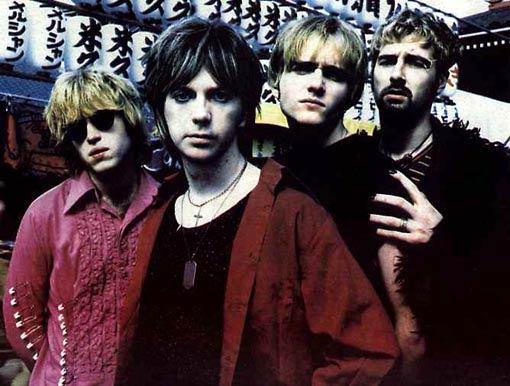We do have some clues. In a 1997 interview with Select magazine, Mansun frontman Paul Draper offered the following explanation:
“Well, The Grey Lantern is like a comic-book hero – the album is about this village of people with really disgusting morals and The Grey Lantern sorts them out. I suppose The Grey Lantern’s me. I wouldn’t have a cape, but there are definitely characters on the record – Albert Taxloss, Chad, Dark Mavis. At the end of the album it all gets resolved and you find Mavis is actually the Stripper Vicar.”
In that same interview, however, Draper also acknowledged that he “ran out of steam” when it came to actually executing his creative vision. He dubbed the finished record “half a concept album – a con album”, and so perhaps it would be a waste of time to examine Attack of the Grey Lantern‘s narrative too closely. Why scrutinise a story when the storyteller himself has all but admitted that it doesn’t bear scrutinising?
Well, because of An Open Letter to the Lyrical Trainspotter, Grey Lantern‘s hidden track.
Here, too, Draper discourages the listener from over-analysing his lyrics:
“The lyrics aren’t supposed to mean that much
They’re just a vehicle for a lovely voice”
But then, in the second verse, we’re given reason to believe that he might be lying:
“You say they mean nothing, just gobbledy-gook
<>But just look at yourself, you’re not clever enough
Understanding the truth, you are so out of touch
You believe all of this, you can’t see it’s a spoof”
An Open Letter to the Lyrical Trainspotter is a deliberately ambiguous song that allows listeners to draw their own conclusions. Either it’s a self-deprecating bit of levity that seeks to pre-empt wanky blog posts like this one by assuring the audience that Attack of the Grey Lantern is just pop music with no deeper meaning…or it’s a joke at the expense of people who would insist the same. You can believe whichever version you like, and I like the latter version because it means I can go on with my wanky post.
You see, Attack of the Grey Lantern is like The Joker as played by Heath Ledger. In the film The Dark Knight, we hear Batman’s archenemy tell the story of how he got his distinctive facial scars: his alcoholic father, after stabbing his mother to death, turned the knife on the young Joker and carved a smile onto his face while asking, “why so serious?”
Except, a little later in the film, The Joker tells a completely different version of the story. This time he claims that he made the cuts himself as a show of solidarity to his then-wife, a gambling addict whose face had been disfigured by loan sharks. Unfortunately, the gesture backfired, and his wife – now unable to stand the sight of him – left and never came back.
Except…towards the end of the film, during his final confrontation with Batman, The Joker goes to tell the story for a third time. He is cut off before he divulges any details, but it’s probably safe to assume that this version would have been different again. It is up to the viewer which story they believe, if any – was it the father? The wife? Was he about to tell Batman the real truth? How many other conflicting explanations has he given?
There’s something similar afoot on Attack of the Grey Lantern. We are first introduced to the character of Mavis in track two, ‘Mansun’s Only Love Song.’ She is looking sexy, hiding in the vestry, speaking of her love for…someone or other. (The Grey Lantern himself, perhaps.)
The next time Mavis’s name comes up is on track six, ‘Stripper Vicar.’
Stripper Vicar‘s lyric consists of two letters to Mavis from The Grey Lantern. The first discusses our hero’s discovery that his local vicar is moonlighting as a stripper, and his ensuing crisis of conscience:
“I though I’d write and ask you your opinion
Should I grass on him, report him to the cardinal?
Or whether I should egg him on to turn professional?”
Letter (and verse) number two is ostensibly written after the vicar’s untimely death:
“Dear Mavis, thought I’d follow up my letter
Drop a line about the fate of our poor vicar
Very tragically, his term on Earth has ended
Found him gagged and bound in stockings and suspenders
Dear Mavis, if you’d tell us what your thoughts are
(And I hope that they’re not biased, ’cause you are the vicar’s daughter!)”
So Mavis is the vicar’s daughter – there it is, in plain English. And yet the final track, ‘Dark Mavis,’ tells a different story: here, The Grey Lantern is speaking to Mavis and the vicar as if they are the same person, and as Paul Draper mentioned in that Select interview, the twist seems to be that they are in fact the same person. Mavis isn’t the vicar’s daughter at all, but some sort of transvestite alter ego – the name he uses when he’s up on stage in his nylon tights and high heels.
But what does that mean for ‘Stripper Vicar?’ Does this mean that The Grey Lantern’s letters were actually addressed to the vicar himself? That they were intended as threats? ‘I know what you’ve been up to, and here’s what will happen if you don’t cut it out’? Which version of events are we supposed to believe? Is Mavis the vicar’s daughter, as ‘Stripper Vicar’ would have us believe? Is she the object of The Lantern’s affection, as ‘Mansun’s Only Love Song’ suggests? Is she merely the vicar’s drag persona, as Dark Mavis supposedly reveals? As with The Joker’s ever-changing backstory, we the audience are left to make up our own minds.
And just as the ultimate goal of Ledger’s Joker is to spread chaos and demonstrate that everyone is corruptible (during the movie’s denouement, he describes the very concept of a moral code as “a bad joke, dropped at the first sign of trouble”), Attack of the Grey Lantern‘s moral – such as it is – seems to be that even a lawful good hero with perfect ethics and a spotless conscience can turn bad when placed in a corrupt environment, like a sponge left soaking in dirty dishwater.
The way I see it, this is actually the end of The Grey Lantern’s story. The album opens with that gorgeously cinematic string motif, which is then embellished by an acoustic guitar and eventually the whole band. Then, suddenly, Paul Draper’s voice comes in and things take a turn for the dramatic:
“All come crashing down, your desperate icon
You’ve got a gob on with your desperate icon”
We are indeed introduced to The Lantern just as his whole life comes crashing down, his moral code abandoned, his messianic self-image in tatters. Until now, he saw himself as a superhero who was put on this Earth to – as Paul Draper put it – “sort out” this group of people with “really disgusting morals”. But instead of redeeming these sordid characters, he allowed himself to become just like them, playing naked Twister in their living rooms and succumbing to his worst, basest urges. He is no better than anybody else; “your shit tastes just as sweet as mine” he concedes as he falls from his pedestal.
The remainder of the album gives us some idea of how The Grey Lantern reached this point. Mavis – and I’m assuming here that she is a real person and not just the vicar in a dress – is the temptation that starts the cogs turning. In ‘You, Who Do You Hate?’ he expresses to some unseen person how much he wishes that he could be them. Lust, envy…that’s two deadly sins in the bag, and we’re not even halfway through the album yet.
But it’s ‘She Makes My Nose Bleed’ that’s the real point of no return.
This is where the string section (last heard in The Chad Who Loved Me) comes back in, representing the moment at which The Grey Lantern – once a beacon of morality and good behaviour – is finally extinguished, becoming defined by his greyness rather than by his lantern light.
By now, The Lantern has realised that Mavis is unattainable and that his feelings for her will never be reciprocated. But instead of just letting it go, he wallows in a swamp of hateful, violent resentment. ‘How dare this woman think herself better than me? Someone ought to take her down a peg or two.’
“Bring her on down by the soles of her feet
Slapping her ’round and making her bleed
I vowed to my god I’d give it all up
If he would bring her on down from heaven”
And there are those strings – those dark, dramatic strings, signalling that the end is nigh. Before you know it – one round of Twister and a shopping trip with Egg Shaped Fred later – you’ve reached closing track ‘Dark Mavis,’ and everything is tumbling down with orchestral grandeur around your ears. The Grey Lantern’s fall from grace is complete, and just to let us know that we’ve come full circle and made it back to where we began, there’s that string motif from the beginning of The Chad Who Loved Me again. Except this time – is it my imagination? – it sounds ever so slightly sadder.
Orginally published here https://thealbumwall.blogspot.com






